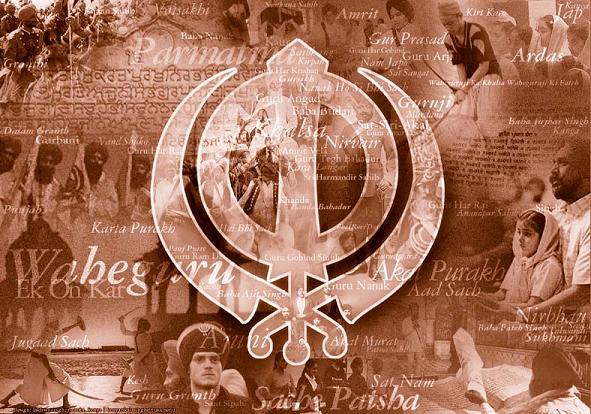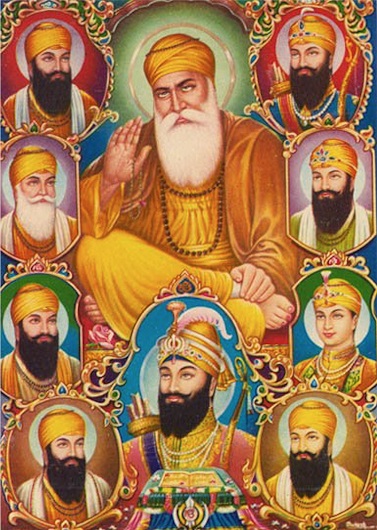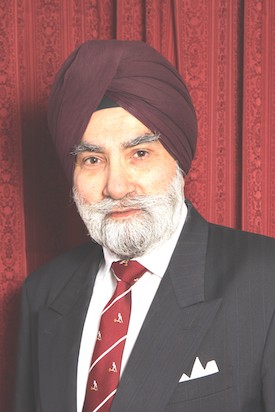Guru Nanak Sahib (1469 - 1539) was the founder of Sikhism, the fifth largest world religion today. He introduced a whole-life system outside the caste system and contemporary religious systems. Guru Nanak resolved to combat superstition and ritualism, and oppression in every sphere of social life at every level. He preached the path of truthful conduct in the robust language of the ordinary working people.
Guru Nanak was a revolutionary who systematically laid the foundation of a new theo-political order. He taught that there is One Supreme Source of all creation (called by whatever name) and no other. Unique amongst world religions, he described the God Being's qualities as: The One Reality Whose Name is ever True; the Creator; Fearless; without enmity; of Eternal Form, Un-incarnate; Self-Existent and Self-illuminating; The Enlightener (The Guru), the Bountiful (and realised through Guru's Own Grace). These are also the qualities towards which a Sikh, the devoted seeker after the Ultimate Reality, aspires. From the interpretation of this founding mystique formula were developed all the institutions of the Order of Khalsa, based on human equality and dignity.
Guru Nanak's mission poses a challenge to the priests and the rulers alike. The Guru's challenge to his Sikh is:
If you wish to play the game of love place your head on the palm of your hand and come my way.
For the Sikh relationship between the human soul and the Creator Being, the Universal Soul, is a loving one with complete trust in the Universal Will (Hukam Razaee) and not one based on fear. A person who takes up this challenge, sets his or her foot on the path of truthful conduct leading to a harmonious relationship with the Lord of every human soul, the Creator Being. Guru Nanak taught that basic humanity and sense of service is more important than religious boundaries; that there must be no discrimination based on gender, race or religion, as all are equal before the One Creator; that all have the God-given right to live with honour, dignity and freedom. He travelled thousands of miles over many years, spreading the divine message throughout the Indian subcontinent and many other Countries.
To ensure continuity and implementation of his vision of an ideal social order, Guru Nanak appointed his successor in his own image. This was repeated from one Guru personality to another. So the nine human Guru personalities following him are also referred to as Nanaks one to ten to stress that the succeeding Guru personalities carried the same light (message) of Guru Nanak. Through selection of worthy successors, the Sikh institutions started by Guru Nanak were developed and consolidated over a period of two hundred years. Nanak X, Guru Gobind Gobind Singh (Guruship 1675 - 1708), made final preparations for the formal introduction of the Khalsa assertive identity and fraternity for organisational strength, common direction and purpose.
Vaisakhi 1699 was the high point of the Sikh tradition. On the Vaisakhi (harvest festival) day in 1699, at Anandpur in Punjab, the Guru initiated the first five Sikhs into the Khalsa Panth (Khalsa means 'the pure directly linked to the Guru' and Panth means 'path' or 'religious order'). These were the Five Beloved Ones (Panj Pyare) who had qualified for admission to the ideal society of Guru Nanak. Thousands then followed to join Khalsa Panth. Vaisakhi 1699 was the climax of all that had gone before and the inspiration of all that was to follow. The Guru introduced an ideal social order based on the precepts of the first Guru personality, Guru Nanak. As a corollary to fearless and truthful conduct expected of the Khalsa, the Guru prescribed a visible distinct identity for the Sikhs. Every Sikh was to keep unshorn hair (kesh) as a living part of the complete human body and symbolising a saintly disposition and physical and spiritual harmony (hair to be covered by a Sikh dastar i.e. Sikh turban); wooden comb (kangha) to keep the hair tidy; a steel bangle (kara) symbolising discipline and allegiance to the Guru; a sword (kirpan) reminding a Sikh of his duty to defend the weak and his/her own honour; and a pair of shorts prepared in a special way (Kachhehra aslo referred to as Kachh or Kachha), to allow agile mobility of the body and symbolising chastity. Thus, kesh (and turban), kangha, kara, kacchehra and kirpan are the Five K s (kakars), gifts of Guru Gobind Singh to the Khalsa. These are not 'symbols' but articles of Sikh faith. Gifts from a loving Guru who sacrificed his parents, his four sons, his own life and all that he possessed for his beloved Khalsa. The Guru's final message to his Sikhs was: Cherish Sikh spiritual and physical discpline, and keep your distinct identity and I shall endow you with my power.
The Khalsa concept emerged as a complete system in 1699: in the form of Khalsa Panth, a nation of saint-soldiers, vested with temporal authority, directed to look at their sacred literature, the Guru Granth Sahib for guidance, and provided with ideals and identity to build their national character. The Khalsa doctrine of double sovereignty (called Miri-Piri) signifies primary allegiance to truth (spiritual aspect); therefore, to oppose any authoritarian regime and to ensure that state must always accept own limitation of power. Sikhs will not tolerate inequality or injustice wherever they live. They must not hide; indeed they cannot hide due to their Guru given distinct identity, and are required to face injustice head on without fear.
Main features of Sikhism are: God-loving monotheism; no brokerage between God and human beings; direct access to the scriptures written in the popular language of the people; freedom from fear; spiritual and temporal balance through the saint-soldier disposition; rejection of monasticism; stress on family life and community obligations; demolition of every traditional excuse used to perpetuate gender bias; rejection of all types of discrimination.


